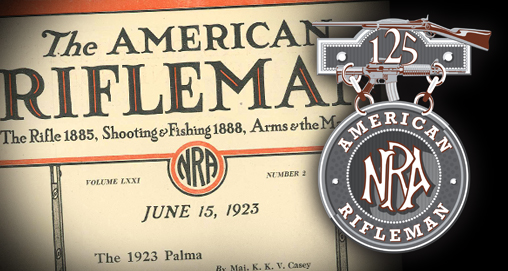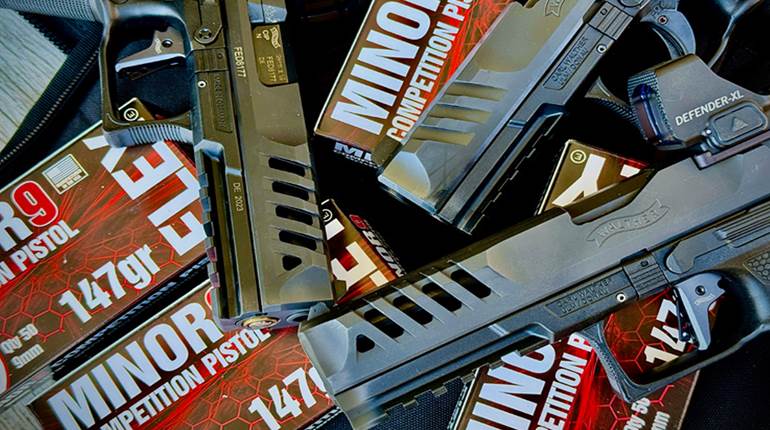
From the February 15, 1924 issue of American Rifleman
An old, old subject but one of so much interest that it seems never to be worn threadbare. The world progresses. Rifles and their ammunition have gone through a series of developments and improvements in the last twenty years along with all other mechanical devices. The vintages of 1886 to 1899 have passed along with the buggy and the horse car. Today we have something new to offer, something that will interest and help the rifleman-hunter.
To begin with I shall make certain assertions, and then I shall endeavor to prove these assertions by what I believe to be a correct interpretation of our own experience, and that of the world’s greatest hunters. At the start, perhaps, I had better state that my sole qualification as to ability to interpret correctly this wealth of information lies in thirty-two years’ study of the sporting rifle, and in big game hunting in three continents covering an equal time, during which, to the best of my recollection I have shot in fair sport, and in the majority of cases unaided by a guide, eighty-six head of big game, including fourteen species, and have been in at the death of probably as many more shot by friends. I have also, perhaps, a rather close acquaintance with a large number of sportsmen and professional hunters of considerable experience who have given me the benefit of their opinions.
My assertions are:
1. We may assume at the outset that any of our series of cartridges from the .38-40 and the .30-.30 up are perfectly satisfactory for deer at moderate ranges. Deer are easily killed animals. Because a weapon and its cartridge are suitable for deer does not necessarily mean that it may also be suitable for other larger game. Big game, from the standpoint of suitable weapons, may be divided into “thick-skinned” and “soft-skinned” game. The first class includes only elephant, rhinoceros, hippopotamus, and African, Indian, and related species of buffalo. Soft-skinned game includes all the other species of big game.
2.Certain cartridges using bullets that may be perfectly satisfactory for North American big game, may fail on larger and tougher soft-skinned game of other countries.
3.Certain cartridges using certain bullets are perfectly satisfactory for use on the soft-skinned game of any country, although from the standpoints of utility certain of these cartridges may require such heavy rifles, and may give such heavy recoil that they would not be considered by the average sportsman. Those which do not require excessively heavy rifles, and which do not give excessive recoil include calibers from .266 inch up to .412 inch diameter of bullet. The bullets must be of a certain weight, and must be designed to mushroom satisfactorily without going to pieces on impact, and the velocity must be such as to favor this. For example, so far our inventors have failed to produce an expanding bullet which will not fly to pieces if the velocity be increased beyond a certain point. The weights of these bullets and the allowable muzzle velocity are shown in the following table. The construction of the bullet will be dealt with hereafter. The minimum velocity is the least that will assure the necessary penetration. The maximum is that above which the bullet suitable for soft skinned game will usually fly to pieces on impact with a combination of flesh and heavy bone. Bullets of a number of constructions are suitable at the lower velocities, but only one type of expanding bullet is suitable at the maximum velocity. Needless to say, this type of bullet at the maximum velocity will give the maximum effect. The maximum velocity also has the advantage of more nearly minimizing the misses which may occur through the errors which the sportsman makes in the estimate of the range.
|
Diam of Bullet |
Minimum Wgt of Bullet |
Maximum Wgt of Bullet |
Minimum Muzzle Velocity |
Maximum Muzzle Velocity |
|
Inches |
Grains |
Grains |
f.s. |
f.s. |
|
.266 |
150 |
165 |
2100 |
2400 |
|
.285 |
160 |
180 |
2100 |
2400 |
|
.308 |
200 |
230 |
2000 |
2400 |
|
.358 |
250 |
300 |
1800 |
2400 |
|
.412 |
300 |
400 |
1600 |
2400 |
4. The only bullet so far found, (excluding the full-jacketed or solid bullets which are only suitable for thick-skinned game) which will mushroom on impact with flesh and bone, and still hold together and penetrate at velocities around 2300 to 2400 f.s., is one having the jacket covering the base, and only partly closed at the point with just a pin head of lead exposed, or else with the point formed with a small hollow extending only through the jacket and not into the core. The jacket of the bullet must be both thick and tough. Heretofore such a bullet has not been produced in the United States.
5. Energy is very misleading as a measure of the killing quality of a bullet. Considered alone it is worthless as such. It will therefore not be considered at all.
Construction of Bullets
1. The .30-.30 bullet. 170 grains. Has proved good on deer at M.V. 2000 f.s., but on larger game, owing to light weight, lacks momentum to always penetrate to the vitals. So much lead exposed, and so thin jacket (about .015-inch) that if the velocity is increased much there will be increased tendency to go to pieces and hence penetrate less.
2. The .30-40 bullet. 220 grains. Owing to its weight it penetrates well at M.V. 2000 f.s., and is suitable for the largest American game. When used in Springfield at M.V. 2300 f.s., and above it often goes to pieces on heavy game owing to the amount of lead exposed and thin jacket (about .02-inch), but enough heavy particles remain to get into the vitals, so it is fairly good, but not nearly as good as No. 4.
3. The .33 W.C.F. bullet. 200 grains. Known as a meat spoiler. The thin jacket, the large amount of lead exposed, and the flat point make it mushroom too quickly. It gives big, superficial wounds but often fails to penetrate. Good on deer, elk, and caribou, but not ideal for moose and bear.
4. The ideal bullet according to our present knowledge of the subject. .30 caliber, 220 grains. Has the weight necessary for deep penetration, and thick jacket and small exposure of lead will hold it together up to velocities of 2400 to 2500 f.s. It mushrooms to good size, but still retains most of its weight, so on all soft-skinned game it can almost always be relied upon to penetrate through heavy flesh and bone straight to the vital parts at which it is aimed.
Bullets Recovered From Game
1. .577-100-750 full-jacketed bullet. Elephant. In ear hole, through brain, and under skin on off side.
2. .30-1906-220 soft point. In behind shoulder of lion, through off shoulder, and lodged under skin. Most of these bullets used on African game mushroomed somewhat more, and some against bone considerably more.
3. .30-1906-150 service full-jacketed. Kongoni shot in chest, cutting first rib and then three medium ribs on off side, and found lying in between meat and skin.
4. .577-100-750 full-jacketed. In behind shoulder of an elephant, passed through the heart, and lodged in its shoulder.
5. .30-1906-150 service full-jacketed. Zebra shot in front of shoulder through shoulder blade, broke rib, and lodged under skin on off side.
6. .30-1906-160 service full-jacketed. Zebra. In behind shoulder, broke point off shoulder, and lodged under skin.
7. .30-1906-220 full-jacketed. Elephant. Through shoulder low down, passing through heart, and found under skin behind off shoulder.
8. .30-1906-180 Oryx Biesa. Passed through shoulder and found in chest cavity.
9. .30-1906-180 open point. Bull moose. In behind shoulder, cutting rib, and pieces found in chest cavity.
10. .30-1906-180 open point. Lion. In behind shoulder, through off shoulder, and found against skin.
11. .30-1906-180 open point. Lioness. In at point of shoulder, and lodged under skin on opposite side. Lungs torn to pieces.
12. .30-1906-180 open point. Lioness. Through both shoulders and found beneath skin on opposite side. Small particles of lead in track of bullet.
13. .577-100-750 soft point. African buffalo. In behind shoulder, broke opposite shoulder, and found against skin near front of off shoulder.
14. .30-1906-180 open point. Lion. Low behind shoulder, broke and lodged in off shoulder, messing up heart badly.
15. .30-1906-180 open point. Lion. Low in shoulder, broke rib on off side, and lodged under skin.
16. .577-100-750 soft point. Large lion. In at the point of shoulder, and and lodged under skin on opposite side after breaking next to last rib on off side.






































